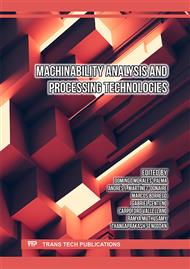[1]
Bautista-Monsalve, F.; García-Sevilla, F.; Miguel, V.; Naranjo, J.; Manjabacas, M.C. A novel machine-learning-based procedure to determine the surface finish quality of titanium alloy parts obtained by heat assisted single point incremental forming. Metals (2021), 11, 1287
DOI: 10.3390/met11081287
Google Scholar
[2]
DeCost, B.L., Hecht, M. D., Francis, T., Webler, B.A., Picard, Y. N., and Holm, E.A. Uhcsdb: UltraHigh carbon steel micrograph DataBase: Tools for exploring large heterogeneous microstructure datasets. Integr. Mat. Manuf. Innov (2017) 6, 197–205
DOI: 10.1007/s40192-017-0097-0
Google Scholar
[3]
DeCost BL, Hecht MD, Francis T, Webler BA, Picard YN, Holm EA Uhcsdb: ultrahigh carbon steel micrograph database. Integr Mater Manuf Innov (2017) 6(2) 197–205.
DOI: 10.1007/s40192-017-0097-0
Google Scholar
[4]
D.S. Bulgarevich, S. Tsukamoto, T. Kasuya, M. Demura, and M. Watanabe, Pattern recognition with machine learning on optical microscopy images of typical metallurgical microstructures, Sci Rep, (2018) 8(1). https://www.nature.com/articles/s41598-018-20438-6
DOI: 10.1038/s41598-018-20438-6
Google Scholar
[5]
D.S. Bulgarevich, S. Tsukamoto, T. Kasuya, M. Demura, and M. Watanabe, Automatic steel labeling on certain microstructural constituents with image processing and machine learning tools, Sci. Technol. Adv. Mater. (2019) 20(1), 532–542. https://dx.doi.org/10.1080/ 14686996.2019.1610668
DOI: 10.1080/14686996.2019.1610668
Google Scholar
[6]
M. Müller, D. Britz, T. Staudt, and F. Mücklich, Microstructural classification of bainitic subclasses in low-carbon multiphase steels using machine learning techniques, Metals (2021) 11(11) 1836.
DOI: 10.3390/met11111836
Google Scholar
[7]
K. Tsutsui, H. Terasaki, T. Maemura, K. Hayashi, K. Moriguchi,and S. Morito, Microstructural diagram for steel based on crystallography with machine learning, Comput. Mater. Sci., (2019) 159 403–11.
DOI: 10.1016/j.commatsci.2018.12.003
Google Scholar
[8]
Muñoz-Rodenas J, García-Sevilla F, Coello-Sobrino J, Martínez-Martínez A, Miguel-Eguía V. Effectiveness of machine-learning and deep-learning strategies for the classification of heat treatments applied to low-carbon steels based on microstructural analysis. Applied Sciences (2023) 13(6):3479
DOI: 10.3390/app13063479
Google Scholar
[9]
Han, L., Liu, Y., Chen, G., Li, K., Wang, J. and Zhou, R., Formation of Graphite Phase in Powder Metallurgical Ultrahigh Carbon Steels with High Wear Resistance. Adv. Eng. Mater. (2018) 20: 1800002
DOI: 10.1002/adem.201800002
Google Scholar
[10]
G. Csurka, C. R. Dance, L. Fan, J. Willamowski, and C. Bray, Visual categorization with bags of keypoints, Workshop on Statistical Learning in Computer Vision (2004), 1–22.
Google Scholar
[11]
E. Nowak, F. Jurie, and B. Triggs, Sampling strategies for bag-of-features image classification, Computer Vision – ECCV Lecture Notes in Computer Science (2006) 3954 490–503
DOI: 10.1007/11744085_38
Google Scholar
[12]
H. Jégou, M. Douze, C. Schmid, and P. Pérez, Aggregating local descriptors into a compact image representation, 23rd IEEE Conference on Computer Vision & Pattern Recognition (2010) 3304–3311
DOI: 10.1109/CVPR.2010.5540039
Google Scholar
[13]
H. Bay, A. Ess, T. Tuytelaars, and L. Van Gool, Speeded-up robust features (surf), Comput. Vis. Image Underst (2008) 110(3) 346–359
DOI: 10.1016/j.cviu.2007.09.014
Google Scholar
[14]
G. Hinton, S. Roweis, Stochastic neighbor embedding, in: Advances in Neural Information Processing Systems (2003) 15 833–840.
Google Scholar
[15]
L. van der Maaten, G. Hinton, Visualizing data using t-SNE, J. Mach. Learn.Res. (2008) 9 2579-2605.
Google Scholar
[16]
Peluffo-Ordóñez, D.H., Lee, J.A., Verleysen, M.: Short review of dimensionality reduction methods based on stochastic neighbour embedding. In: Villmann, T., Schleif, F.-M., Kaden, M., Lange, M. (eds.) Advances in Self-Organizing Maps and Learning Vector Quantization. AISC, 295, 65–74. Springer, Cham (2014)
DOI: 10.1007/978-3-319-07695-9_6
Google Scholar
[17]
Berrendero JR, Cuevas A, Torrecilla JL The mRMRvariable selection method: a comparative study for functional data.J. Stat. Comput. Simul. (2016) 86(5) 891–907.
DOI: 10.1080/00949655.2015.1042378
Google Scholar
[18]
Peng H., Long F., Ding C. Feature selection based on mutual information criteria of max-dependency, max-relevance, and min-redundancy, IEEE Trans. Pattern Anal. Mach. Intell. (2005) 27 (8) 1226-1238.
DOI: 10.1109/tpami.2005.159
Google Scholar
[19]
C-L Fan, Evaluation of Classification for Project Features with Machine Learning Algorithms, Symmetry (2022)14(2):372
DOI: 10.3390/sym14020372
Google Scholar
[20]
Fawcett T. An introduction to ROC analysis. Pattern Recognition Letters (2006) 27(8) 861–874.
DOI: 10.1016/j.patrec.2005.10.010
Google Scholar
[21]
Xu-hui, W., Ping, S., Li, C., Ye, W. (2009). A ROC curve method for performance evaluation of support vector machine with optimization strategy. In 2009 International Forum on Computer Science-Technology and Applications (IEEE) (2009) 2 117–120.
DOI: 10.1109/ifcsta.2009.356
Google Scholar



